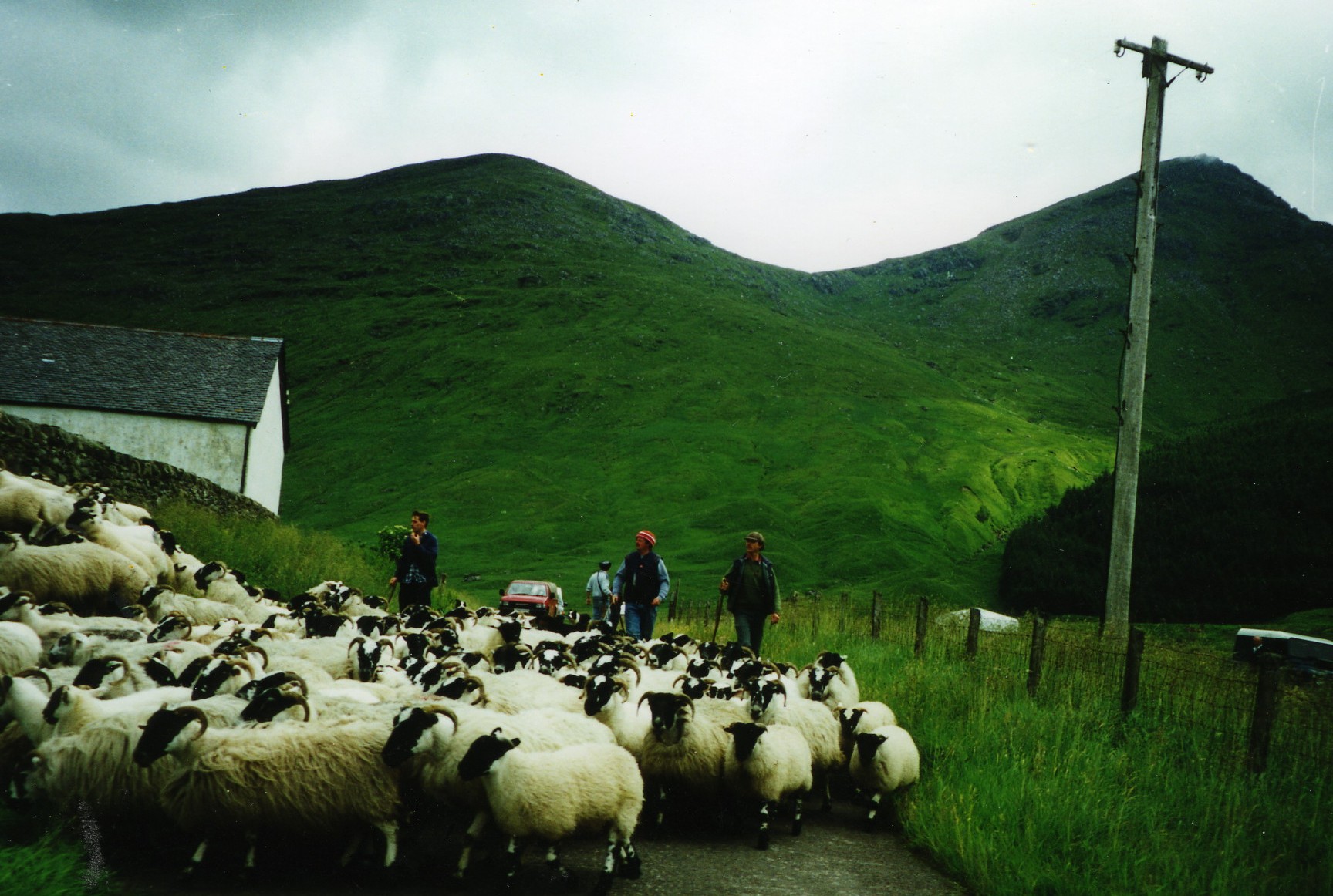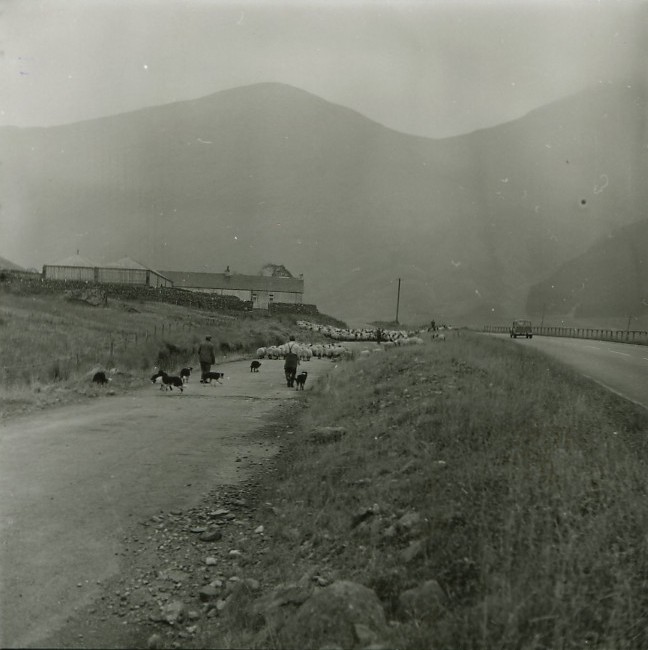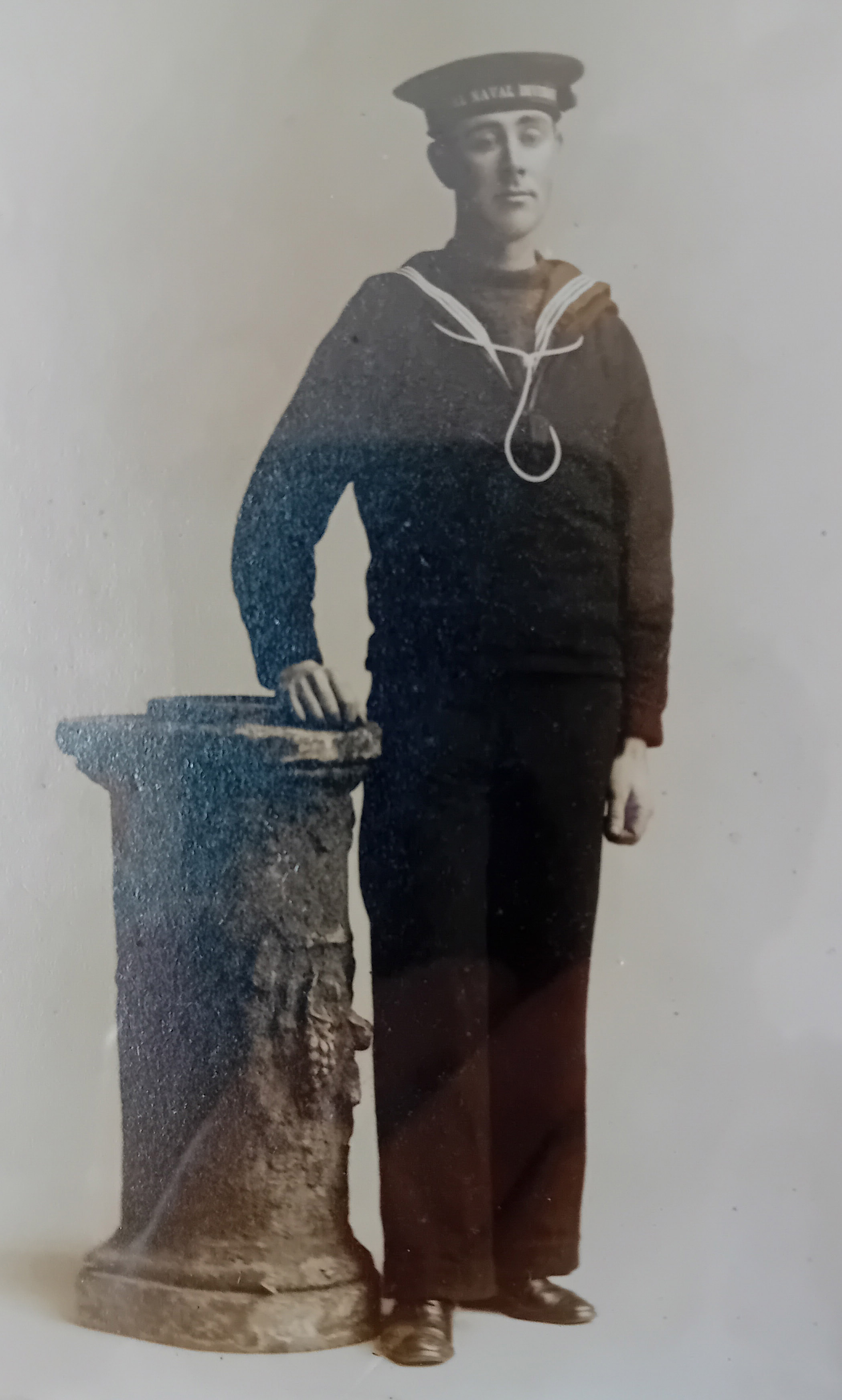Butterbridge | 88 occupants (1851 - 1999)
2016 derelict.
Butterbridge Cottage
i. General
Butterbridge Cottage lies on the north side of the main road about half way up Glenkinglas. The site sits at the end of a long straight, just W of where the main road angles back up to the Rest-and-be-thankful pass to the south. It is in viewing distance of Ben Ime House, assessed in January 2010. Butterbridge Cottage consists of a single storied range aligned north-south, whose principal frontage is east facing. The range comprises a cottage to the south and beyond an internal masonry cross wall that rises to a chimney stack what is now used as a barn further north. This may have been a barn or byre originally, with entrances in both sides, E and W, of this. Abutting the west side of the northern part of the range is a large covered roofed area of pens, shearing and sheds etc. a large steading complex. Further pens are built of drystone walls to the S of the steading/byre ranges. These external pens are unroofed.
ii. The steading complex
The walls of the steading complex are apparently of some reasonable age, built of coursed masonry of field stone and in profile quite tapering. The timber superstructure is built over and around these walls, which were clearly pre-existing and most of the exterior walls of the superstructure rise up to a little over a metre and are of cement and blockwork. The walling above this is of slatted woodwork, supported principally by a series of blockwork and cement bedded vertical piers. The roof structure upon this is east-west aligned and is of a double piled construction with ends that are hipped at the east and west. The steading complex is internally subdivided by further masonry walls; the beams are mostly pointed up with cement. Internally, there are a variety of gates and small pens, enclosures etc. for the management of livestock. It is apparent that the earlier masonry walls within this area are pre-existing and relate to the farming functions of Butterbridge Cottage itself.
The walls of the pens appear on the First Edition Ordnance Survey Map (6 inch, surveyed 1870). The footprint of the roofed over area is not exactly similar to the 1870’s OS map and it seems likely that the present roof replaces and expands from a previous roof, as recorded in the late 19th century.
The cottage is accessed by a small gravel track up along its east side. At one or two points there are signs of cobbling or perhaps stone edging for flowerbeds. Opposite the principal entrance to the cottage there is a small stone lined drain, with a very small burn running within it. Over this a small bridge leads to a small drystone dyke enclosing a former garden area, now somewhat overgrown with the occasional surviving daffodil within and one or two other relic plants, such as honeysuckle. This matches with the footprint of a small outbuilding on the First Edition OS map of which the walls could be the surviving remains.
iii. The cottage and byre – exterior
The north-south aligned cottage and byre range is built upon land that slopes down gently to the south. Because of this topographical situation, the south gable is very much higher than the north gable of the range and the cottage at the south end is built up effectively upon of a platform. The range appears to be all of one period with some later modifications. It is rubble built, upon a large projecting footing course formed of small boulders. The southern parts of the west wall and the south gable are all rendered in cement and the south gable itself is ruled out (to suggest cut stone). The principal entrance elevation to the east is fairly heavily pointed up in cement though the rubble work construction is readily apparent. It appears that the quoining, although quite obscured, is generally of rubble stone construction – large slabs of mixed stone, principally schist.
The cottage roof is slated with West Highland slates in diminishing courses, rising up to a zinc ridge piece. The cottage has a solitary chimney. This is located at the internal crosswall between cottage and byre further north. The chimney appears to be stone built with a projecting course at the base and a further projecting course just below the top. It has a terracotta chimney pot upon.
The principal elevation of the cottage is of tripartite form, with tall fairly narrow windows on either side of the principal entrance. The entrance is now obscured by a porch and its exterior face within the porch obscured further by internal linings. The porch is built upon a cement blockwork base with some evidence of poured concrete at the very foot. The original porch seems to have been extended to the north, which is formed of bricks. Within this a stair rises up from the present porch entrance at the north end. Further stairs rise up to the south into the porch proper and the entrance to the house.
The porch superstructure is wooden framed and clad with corrugated asbestos sheeting. There are two windows within the porch, in the upper part opposite the entrance, is a window of relatively modern construction with central mullion. The window within the northern compartment where the stair is, is simply a sheet of translucent corrugated plastic sheeting. There does not seem to have been a window within here. The door to the porch is modern. This door is simply framed with angle bases internally and boarded with tongue and grove boarding externally.
A little upslope from the porch to the north is a small lean-to structure that appears to be brick built and cement rendered. This may have been an outside larder. There is a small window in its north side with fly mesh on it. Internally there are fittings for three shelves below supported by small vertical piers formed of cement blockwork. The floor of the structure is cement and the roof is of corrugated iron, but with a cement slab poured over. Little now remains of the shelves within other than stumps on the east side. These reveal slabs of slate which had been in there apparently confirming the use as a cold store.
The structure is rendered in cement externally and plastered internally with cement. It has a simple plank and batten door within the small entrance on the south side. It now contains a grant euroframe heating system which may be defunct.
The small square window (third window from S, the kitchen window) appears possibly to have been an entrance originally - there are hints of coining running down to the ground. The lower part of this is infilled and there is now a drainage pipe and fixing etc running out of it.
The byre section of the range to the north is accessed by two entrances. Now the main central entrance appears to be a widening, which may or may not have been a pre-existing entrance further north upslope. There is also a small original entrance. This is simply formed with a coarsely hewn or undressed rubble quoining. The principal entrance in the centre is accessed by concrete steps. The entrance itself contains a modern door that slides within runners northwards. On either side of this there are two early window openings. These are simply formed of rubble stone with large slabs for lintels and sills.
There is a slight survival of a horizontal cement or mortar fillet, two-thirds of the way up the north gable indicating that there had been a later lean-to structure at some point in time. This ran across the upper window opening. The west exterior wall of the byre now seen within the later covered area are three early openings, two of which are entrances with large slab-like lintels and simply hewn rubble stoned coining at the jambs. At the very north end of the west wall there is a small window opening, again roughly formed and apparently a later insertion. The jambs of which are of rebedded rubble in cement work. The box bedroom window (room to W of kitchen) is seen externally occupying the southern part of the byre block, is clearly a secondary insertion, flaking render revealing cemented brickwork.
iv. The cottage and byre – interior
Internally, the stair leading up to the main porch chamber is framed and lined out with plasterboard but is painted on to the masonry on the cottage frontage side to the west. The porch interior proper is similarly lined out with plasterboard. There is one step up through the original principal entry. The entrance contains a plank and batten door with a later glazed panel inserted. The planks are tongue and groove with a narrow bead at the joint on the exterior side to the east. There is a simple iron box lock within. This leads into a long north-side aligned entrance vestibule. This along with much of the rest of the interior is wholly lined out with three inch V-section match boarding. The ceilings are similarly lined out above a simple moulded cornice. Within the entrance it was clear that there had been a small two paned light above the door itself. The glazing bar of this is of fillet-and-ovolo profile and appears relatively late , ca. 19th/early 20th century. The hall’s only feature is a large coat rack running south from the entrance. This has a series of seven cast iron hooks. The hall is decorated up to a small dado rail, with a beige below and a pinkish-cream above.
The entrance hall is symmetrically arranged. To the north and south there are entrances into the principal rooms, and at the north and south ends of the west wall, there are further entrances into the middle rooms of the cottage. Throughout the rooms, the linings rise up from a simple skirting with an ogee moulded upper moulding.
The southern room – (S bedroom) was lit by a single window to the east that is sash and case, now boarded up. Somewhat curiously. the lower case is three above three, the upper case two above two. All of this is fillet-and-ovolo moulded. The ingoes as throughout the building are also matchboard lined with a simple architrave surrounding with angle rolls. There is a wall press at the east end of the south wall. The door to the press is a plain plank and batten door tongue and grooved, the boarding is with an arrow bead lined out within four shelves. In the centre of the south gable wall there is what appears to be a patching over of what had likely been the site of a fireplace. This is confirmed by a break in the skirting and a hearth stone; otherwise the room is without feature. The door into the room from the hall has plank and batten construction.
The room entered at the south-west corner of the entrance hall (SW bedroom) is again simply appointed, lined out throughout. This appears to have been a box bedroom. The lining board is painted in vertical stripes of yellow and pale blue/grey alternating. In places the chipping paint reveals a salmon pink earlier colour beneath. There is a single window in the west wall. This has a modern frame within, glazed panel below and an upper glazed panel that opens, hinged at the top. Window and door have architraves around with an ogee outer and a roll at the inner angle, plank and batten door within. .
The entrance at the north-west corner of the vestibule leads to a bathroom. This is fully lined out as elsewhere, with a single window in the west wall and a modern window within. There is a fixed glazed panel below, and an opening hinged at the top upper glazed panel. The door is a plank and batten construction with architraves as elsewhere. The interior is painted with a pink ceiling, the vertical lining boards are alternating pink and cream, every second pair of boards is pink and then cream. The cast iron enamelled bathtub sits against the south wall, offset to the east. A basin is to the southwest, Armitage Shanks, this is boxed in. The WC with black bakelite fixings and ceramic pan to the northwest has a pipe up to a cistern with a pull chain. There is a roof hatch in the bathroom, but the roof structure is not accessible.
The principal room (living room) lies to the north. Again it is lined out as elsewhere with a plain dado rail applied. The room is painted in turquoise below this and a mint-blue above. The single window is in the east wall, sash and case construction, six paned below, four paned above – fillet-and-ovolo glazing bar profile, ingoe lined out, simple architrave as elsewhere. The principal feature of the room is a large centrally positioned fireplace in the north wall, rising up to the chimney that can be seen externally. The fireplace is of two phases. There is an earlier surround which appears to be of stone or possibly cement, painted white, rising up to a wooden mantelshelf. The interior of this, which may have contained a small cast iron range, is now in filled with a ceramic built fireplace of small bricks with terracotta tiles on top and a half-stone area similarly constructed of terracotta. There is a small enamelled metal grating within. This is now partly painted black. Suspended above the area of the fireplace offset to the north side of the room is a laundry hoist or pulley.
There are small entrances to the north-west and north-east. The north-east entrance leads into a small kitchen, through a plank and batten door. The kitchen interior itself is very 1970s in style, simple fitted units of white formica with white handles, subsequently painted red. This interior is lit by an iron framed window at the north end of its east wall. The window itself is divided by a broad central mullion into a N and S part. There are iron frames on either side of the central mullion – each pane with three glazed panels, two further panels below are now in filled with board. The northern window was hinged to the north. The south window has a single small hinged opening in the upper pane. There exists what appears to have been a small press or possibly a blocked entrance. This has an architrave around rising up to a small moulded cornice.
The entrance at the north-west corner of the principal northern room leads into a small boxroom (room to W of kitchen). This is provided with a single window on the west side of similar construction to the kitchen window i.e. iron framed on either side of the mullion. This interior is wholly plasterboarded. A hole in the plasterboard reveals a limewashed rubble construction behind. This is clearly indicating a utilitarian interior, possibly part of the byre itself. It does seem that the boxroom and the kitchen were a later addition to the original cottage – perhaps the two entrances were broken through at the points of pre-existing presses at the two wall angles of main room.
It appears that the kitchen window may have been formed up in brickwork although this is mostly obscured. Visible from the byre interior, the kitchen and boxroom are sub-divided from the remainder of the byre interior by an east-west aligned masonry crosswall that rises up to internal wallhead height. Above this the southern part is segregated by later cement blockwork. The masonry subdivision is of rubble construction lime bonded and appears to be part of the original build of the range overall.
Internally, the byre is coarsely pointed up and whitewashed over. The two windows to the east have simple wooden lintels. The principal eastern entrance is confirmed to be recent by cement blockwork and cement bedded brickwork on either side of the jams. This is possibly a widening of the pre-existing opening.
The northern part of the interior is subdivided off by an east-west aligned cement blockwork built wall, this with an entrance to the east and containing a reused plank and batten door. Throughout the interior the flooring is now concreted over.
The roof is of simple A-frame construction of sawn rectangular section rafters that are half lapped at the apex with single collars below, which are also half lapped at either end. Collar ends have crudely wrought chamfer. At the north gable the ground rises up and there is some suggestion of a built platform which presumably one could back a cart up to. The gable end had had a ground floor entrance that is now bricked up, visible internally, and a smaller loft entrance above indicating that at least the northern part of this range has had a floor likely for a hayloft.



















